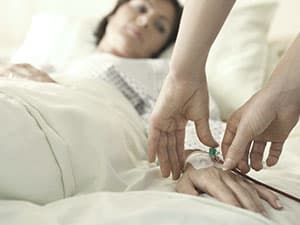Anorexia Treatment Programs
 Anorexia is an eating disorder characterized by a low body mass index (BMI), a fear of gaining weight, severe self-induced weight loss, and an abnormal perception of body weight and shape. Anorexia is most common among teenage girls, affecting up to 0.7% of this age group. But it also appears in men and adults.1,2
Anorexia is an eating disorder characterized by a low body mass index (BMI), a fear of gaining weight, severe self-induced weight loss, and an abnormal perception of body weight and shape. Anorexia is most common among teenage girls, affecting up to 0.7% of this age group. But it also appears in men and adults.1,2
This article will cover the following topics:
- Is there a cure for anorexia?
- Residential inpatient treatment
- Outpatient treatment programs
- Luxury and executive facilities
- Therapies for anorexia
- Prescription and over-the-counter medications
- Support groups and 12-step programs
- How to find the best anorexia treatment centers
Is There a Cure for Anorexia?
Anorexia is a notoriously difficult disorder to treat. But recovery is possible. Anorexia recovery requires long-term commitment, and relapses are common, particularly during stressful periods. Studies show that early intervention offers the best chance of recovery.1
The first goal of anorexia treatment is to restore a normal, healthy body weight. Some people elect for outpatient anorexia treatment. However, if the person seeking treatment is dangerously underweight, they may need to first enter a hospital.
Anorexia recovery centers often combine psychotherapy with medical treatment and nutritional support. Professionals will structure rehab differently for each individual. In therapy, patients can address other mental health issues that may be contributing to their anorexia, such as depression and anxiety.
Dietitians and other healthcare providers at anorexia rehab centers will help patients change their old habits and beliefs about food and dieting. They will help the patient develop a healthy relationship with exercise, often reducing the amount of daily activity.
Overcoming Denial
The person with anorexia needs to participate fully in her own therapy. Many people with anorexia do not realize that they have a problem, so convincing them to participate can be difficult. People with anorexia usually maintain a distorted view of their body, and they may not realize how dangerously thin they have become.
How Many People Recover?
A summary of anorexia treatment studies says that 47% of people recover completely and 34% of people improve. However, relapse is common, and 21% of patients develop a chronic eating disorder.
Anorexia is extremely dangerous – a startling 5% of patients will eventually die from the disease.1
Hospitalization
People with anorexia often delay treatment until their condition gets very serious or even life-threatening. Ifa person’s life is in danger, she may need to seek treatment in the hospital. In the hospital, emergency room doctors will monitor vital signs and treat issues such as heart rhythm disturbance, dehydration, electrolyte imbalances, or psychiatric emergencies.
Hospitalization may be necessary if malnutrition is causing medical complications. If a patient continues to refuse to eat in treatment, they may also require hospitalization. In severe situations, a patient might require feeding through a tube that goes into their stomach through their nose.
Residential Inpatient Treatment
 Residential inpatient rehab centers are an alternative to full hospitalization. Patients live at the facility and get around-the-clock treatment from eating disorder specialists. Many people find that an intensive inpatient program is the best way to start the recovery process.
Residential inpatient rehab centers are an alternative to full hospitalization. Patients live at the facility and get around-the-clock treatment from eating disorder specialists. Many people find that an intensive inpatient program is the best way to start the recovery process.
People at residential anorexia recovery programs benefit from a comprehensive rehabilitation program with a multifaceted approach. They will receive medical care from physicians who specialize in treating eating disorders. Physicians will help patients find medications that can improve their mental health. People will also receive individual therapy from trained professionals and will meet other people suffering from anorexia in group therapy sessions.
After patients start to gain weight and are no longer at risk of severe malnutrition or suicide, they typically transfer to an outpatient program to continue their therapy.
Suicide Risk
Assessing suicide risk is a critical component of anorexia treatment, especially for people with other psychiatric illnesses. People with anorexia are at an extremely high risk of suicide. Half of all anorexia-related deaths are from suicide.2 A residential rehab program provides a safe space for an evaluation of suicidal ideation.
If you need help finding a residential anorexia treatment program, or if you’re looking for another type of recovery program, call our confidential helpline at .
Outpatient Treatment Programs
Outpatient anorexia recovery centers also provide specialized care for eating disorders. The treatment center might offer daily or weekly therapy sessions either on an individual or group level. In treatment, people may also work with a dietitian or nutritionist to develop a healthy eating schedule. The person in treatment continues to live at home instead of living at the rehab center.
Working with a psychotherapist the person trusts will go a long way toward maintaining healthy eating habits. Individual therapy can help the person develop a positive body image and change the feelings and behaviors that led to anorexia. Individual therapy programs also teach people how to deal with stressful life situations and how to avoid relapsing.
Luxury and Executive Facilities
Luxury and executive facilities are residential treatment centers that offer extra amenities for those in treatment, including accommodations for working professionals. These treatment centers are sometimes found in peaceful environments such as horse ranches, beach houses, or even converted old mansions.
They offer residential quarters that resemble nice hotel rooms, and they may offer work stations for professionals to work remotely or to manage flexible work schedules.
Luxury anorexia recovery programs offer all the conventional medical and psychological treatments, such as individual, group, and family therapy. But they frequently will also provide alternative treatments such as massage, mindfulness, meditation, yoga, acupuncture, and biofeedback.
Therapies for Anorexia
Anorexia rehab involves several different types of therapy.
- Cognitive behavioral therapy (CBT): The main goal of this therapy is to help people normalize their eating patterns and behaviors. Patients also address their distorted body image.3
- Family-based treatment (FBT): This is an evidence-based treatment program that has been successful for teenagers. It mobilizes parents to help their children with re-feeding and weight gain.3
- Adolescent-focused therapy (AFT): When FBT is not an option, this form of individual therapy can be useful for teenagers. Adolescents in AFT take control of their own eating patterns and weight gain. Their relationship with their therapist supports them during this process.4
- Nutritional counseling: Dietitians teach patients about healthy eating and nutritional planning to help them modify maladaptive eating behaviors.
- Alternative therapies: Alternative medicine complements more conventional treatment, helping reduce patients’ anxiety levels. Activities such as yoga, massage, acupuncture, and meditation can promote relaxation and well-being.
Call to get more information about anorexia treatment centers and therapies.
Prescription and Over-the-Counter Medications
The following is a list of medications that may be prescribed during the anorexia treatment process:
- Antidepressants: Selective serotonin reuptake inhibitors (SSRIs) are antidepressants that help some people with anorexia manage any associated OCD, anxiety, and/or depression. 2
- Antihistamines: Off-label, the prescription drug cyproheptadine has been used with varying levels of success to stimulate appetite in people with anorexia.2
- Antipsychotics: These can help stabilize mood, especially during mental health crises.5
- Dietary supplements: Vitamin and mineral deficiencies from anorexia can cause health problems and cognitive disabilities. A physician may prescribe iron and potassium supplements or recommend multivitamins, omega-3 fatty acids, and probiotics to help correct these deficiencies. 2
- Herbs: With the advice of a doctor, herbs in the form of capsules, tablets, or teas can help support and strengthen the body. Herbs such as fenugreek, milk thistle, and catnip have been reported to help stimulate appetite, soothe the digestive system, and calm the nerves.2
Support Groups and 12-Step Programs
 Support groups are often a part of the multifaceted approach to anorexia recovery. In these groups, people in anorexia recovery and their families can share their stories with one another. It can be comforting to hear others speak about their struggles, which may be similar to yours. Your local community center or church might offer eating disorder support groups.
Support groups are often a part of the multifaceted approach to anorexia recovery. In these groups, people in anorexia recovery and their families can share their stories with one another. It can be comforting to hear others speak about their struggles, which may be similar to yours. Your local community center or church might offer eating disorder support groups.
Twelve-step programs are also available for eating disorders. Eating Disorders Anonymous uses the same 12-step approach as Alcoholics Anonymous. People go to these free meetings to support each other’s recovery. Newcomers find a veteran of the program to “sponsor” or personally support them. This person is usually in long-term recovery from anorexia.
Online groups are available if you can’t find an Eating Disorders Anonymous group near you. Check out their website for information about online, phone, and Skype meetings.
Types of anorexia support groups include:
- Eating Disorders Anonymous: EDA is a 12-step peer support treatment program.
- Peer-to-peer groups: People with eating disorders and their families organize these community groups.
- Outpatient group therapy: A professional moderates these groups. They usually meet at hospitals and anorexia treatment centers.
How to Find the Best Anorexia Treatment Centers
Anorexia is extremely dangerous. If you see signs of anorexia in yourself or someone you know, get help right away. Our knowledgeable treatment support staff can help you find a treatment program that will work for you.
Call our helpline today at to speak with someone about your options.
Read next: Getting Help With Anorexia
Sources
[1]. Lock, J., & Fitzpatrick, K. K. (2009). Anorexia nervosa. BMJ Clinical Evidence, 2009, 1011.
[2]. University of Maryland Medical Center. (2015). Anorexia nervosa. Complementary and Alternative Medicine Guide.
[3]. The Mayo Clinic. (2016). Anorexia nervosa. Patient Care and Health Information.
[4]. Lock, J., & La Via, M. C. (2015). Practice parameter for the assessment and treatment of children and adolescents with eating disorders. Journal of the American Academy of Child & Adolescent Psychiatry, 54(5), 412-425.
[5]. National Institutes of Health. (2016). Anorexia.

